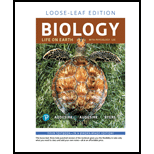
Pearson eText Biology: Life on Earth with Physiology -- Instant Access (Pearson+)
12th Edition
ISBN: 9780135755785
Author: Gerald Audesirk, Teresa Audesirk
Publisher: PEARSON+
expand_more
expand_more
format_list_bulleted
Concept explainers
Question
Chapter 37, Problem 2MC
Summary Introduction
Introduction:
Innate defense is also known as nonspecific defense. It provides general response regardless of pathogen type and exposure numbers. The innate mechanism includes mechanical barrier, natural killer cell, chemical barriers, fever, inflammation, and phagocytosis.
Expert Solution & Answer
Want to see the full answer?
Check out a sample textbook solution
Students have asked these similar questions
Molecular Biology
LIST three characteristics of origins of replication
Molecular Biology Question
Please help. Thank you
For E coli DNA polymerase III, give the structure and function of the b-clamp sub-complex. Describe how the structure of this sub-complex is important for it’s function.
Molecular Biology
LIST three characteristics of DNA Polymerases
Chapter 37 Solutions
Pearson eText Biology: Life on Earth with Physiology -- Instant Access (Pearson+)
Ch. 37.1 - compare and contrast the terms microbe and...Ch. 37.1 - Prob. 2CYLCh. 37.2 - Prob. 1TCCh. 37.2 - If phagocytes kill most species of bacteria that...Ch. 37.2 - describe the external barriers to Infection,...Ch. 37.2 - Prob. 2CYLCh. 37.3 - Prob. 1CYLCh. 37.3 - Prob. 2CYLCh. 37.4 - Prob. 1TCCh. 37.4 - Prob. 1CYL
Ch. 37.4 - Prob. 2CYLCh. 37.4 - Prob. 3CYLCh. 37.5 - Prob. 1CYLCh. 37.5 - Prob. 2CYLCh. 37.6 - Prob. 1CYLCh. 37.6 - Prob. 2CYLCh. 37.7 - Prob. 1HYEWCh. 37.7 - Prob. 1TCCh. 37.7 - explain how antibiotics, antiviral drugs, and...Ch. 37.7 - Prob. 2CYLCh. 37.8 - What might be the evolutionary advantage of...Ch. 37.8 - Prob. 1CYLCh. 37.9 - Prob. 1CYLCh. 37.9 - describe current medical treatments against...Ch. 37.9 - Prob. 1CTCh. 37 - Prob. 1MCCh. 37 - Prob. 2MCCh. 37 - Molecules that label your cells as self are a....Ch. 37 - Prob. 4MCCh. 37 - The immune system usually does not attack your...Ch. 37 - External defenses against microbial invasion...Ch. 37 - Prob. 2FIBCh. 37 - Prob. 3FIBCh. 37 - Prob. 4FIBCh. 37 - Prob. 5FIBCh. 37 - Prob. 6FIBCh. 37 - Prob. 1RQCh. 37 - Prob. 2RQCh. 37 - Describe humoral immunity and cell-mediated...Ch. 37 - Prob. 4RQCh. 37 - Prob. 5RQCh. 37 - Prob. 6RQCh. 37 - Prob. 7RQCh. 37 - What are memory cells? How do they contribute to...Ch. 37 - Prob. 9RQCh. 37 - Prob. 10RQCh. 37 - Prob. 11RQCh. 37 - Prob. 12RQCh. 37 - Prob. 13RQCh. 37 - Why is it essential that antibodies and T-cell...Ch. 37 - Prob. 2AC
Knowledge Booster
Learn more about
Need a deep-dive on the concept behind this application? Look no further. Learn more about this topic, biology and related others by exploring similar questions and additional content below.Similar questions
- Molecular Biology RNA polymerase core enzyme structure contains what subunits? To form holo enzyme, sigma factor is added to core. What is the name of the structure formed? Give the detailed structure of sigma factor and the function of eachdomain. Please help. Thank youarrow_forwardMolecular Biology You have a single bacterial cell whose DNA is labelled with radioactiveC14. After 5 rounds of cell division, how may cells will contain radioactive DNA? Please help. Thank youarrow_forward1. Explain the structure and properties of atoms and chemical bonds (especially how they relate to DNA and proteins). Also add some pictures.arrow_forward
- 1. In the Sentinel Cell DNA integrity is preserved through nanoscopic helicase-coordinated repair, while lipids in the membrane are fortified to resist environmental mutagens. also provide pictures for this question.arrow_forwardExplain the structure and properties of atoms and chemical bonds (especially how they relate to DNA and proteins). Also add some pictures.arrow_forwardIn the Sentinel Cell DNA integrity is preserved through nanoscopic helicase-coordinated repair, while lipids in the membrane are fortified to resist environmental mutagens. also provide pictures for this question.arrow_forward
- 1. Explain how genetic information is stored, copied, transferred, and expressed. Also add some pictures for this question.arrow_forward!. Describe biological macromolecules (DNA, RNA, proteins, lipids, etc.) and how they function in the cell. also provide some images for this question.arrow_forwardI need assistance with experienced tutor. Thanks.arrow_forward
- H3C H Br-Br C=C H₂O H3C-CH2 CH3 (large excess)arrow_forwardmarvin dunham, a 68 year old male, is admitted to the hospital with a deep laceration to the forehead. dr. wallace applies a pressure dressing to his head to control the bleeding. what is the pcs codearrow_forwardExplain the impact William B. Travis has made.arrow_forward
arrow_back_ios
SEE MORE QUESTIONS
arrow_forward_ios
Recommended textbooks for you
 Medical Terminology for Health Professions, Spira...Health & NutritionISBN:9781305634350Author:Ann Ehrlich, Carol L. Schroeder, Laura Ehrlich, Katrina A. SchroederPublisher:Cengage Learning
Medical Terminology for Health Professions, Spira...Health & NutritionISBN:9781305634350Author:Ann Ehrlich, Carol L. Schroeder, Laura Ehrlich, Katrina A. SchroederPublisher:Cengage Learning
 Concepts of BiologyBiologyISBN:9781938168116Author:Samantha Fowler, Rebecca Roush, James WisePublisher:OpenStax College
Concepts of BiologyBiologyISBN:9781938168116Author:Samantha Fowler, Rebecca Roush, James WisePublisher:OpenStax College

Medical Terminology for Health Professions, Spira...
Health & Nutrition
ISBN:9781305634350
Author:Ann Ehrlich, Carol L. Schroeder, Laura Ehrlich, Katrina A. Schroeder
Publisher:Cengage Learning




Concepts of Biology
Biology
ISBN:9781938168116
Author:Samantha Fowler, Rebecca Roush, James Wise
Publisher:OpenStax College

Immune System and Immune Response Animation; Author: Medical Sciences Animations;https://www.youtube.com/watch?v=JDdbUBXPKc4;License: Standard YouTube License, CC-BY
Immune response: summary; Author: Dr Bhavsar Biology;https://www.youtube.com/watch?v=ADANgHkX4OY;License: Standard Youtube License